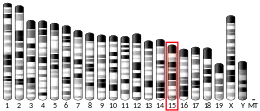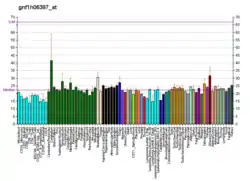HOXC9
Homeobox protein Hox-C9 is a protein that in humans is encoded by the HOXC9 gene.[5][6]
| HOXC9 | |||||||||||||||||||||||||||||||||||||||||||||||||||
|---|---|---|---|---|---|---|---|---|---|---|---|---|---|---|---|---|---|---|---|---|---|---|---|---|---|---|---|---|---|---|---|---|---|---|---|---|---|---|---|---|---|---|---|---|---|---|---|---|---|---|---|
| |||||||||||||||||||||||||||||||||||||||||||||||||||
| Identifiers | |||||||||||||||||||||||||||||||||||||||||||||||||||
| Aliases | HOXC9, HOX3, HOX3B, homeobox C9 | ||||||||||||||||||||||||||||||||||||||||||||||||||
| External IDs | OMIM: 142971 MGI: 96199 HomoloGene: 130558 GeneCards: HOXC9 | ||||||||||||||||||||||||||||||||||||||||||||||||||
| |||||||||||||||||||||||||||||||||||||||||||||||||||
| |||||||||||||||||||||||||||||||||||||||||||||||||||
| |||||||||||||||||||||||||||||||||||||||||||||||||||
| |||||||||||||||||||||||||||||||||||||||||||||||||||
| |||||||||||||||||||||||||||||||||||||||||||||||||||
| Wikidata | |||||||||||||||||||||||||||||||||||||||||||||||||||
| |||||||||||||||||||||||||||||||||||||||||||||||||||
Function
This gene belongs to the homeobox family of genes. The homeobox genes encode a highly conserved family of transcription factors that play an important role in morphogenesis in all multicellular organisms. Mammals possess four similar homeobox gene clusters, HOXA, HOXB, HOXC and HOXD, which are located on different chromosomes and consist of 9 to 11 genes arranged in tandem. This gene is one of several homeobox HOXC genes located in a cluster on chromosome 12.[6]
See also
References
- GRCh38: Ensembl release 89: ENSG00000180806 - Ensembl, May 2017
- GRCm38: Ensembl release 89: ENSMUSG00000036139 - Ensembl, May 2017
- "Human PubMed Reference:". National Center for Biotechnology Information, U.S. National Library of Medicine.
- "Mouse PubMed Reference:". National Center for Biotechnology Information, U.S. National Library of Medicine.
- McAlpine PJ, Shows TB (July 1990). "Nomenclature for human homeobox genes". Genomics. 7 (3): 460. doi:10.1016/0888-7543(90)90186-X. PMID 1973146.
- "Entrez Gene: HOXC9 homeobox C9".
Further reading
- Acampora D, D'Esposito M, Faiella A, Pannese M, Migliaccio E, Morelli F, Stornaiuolo A, Nigro V, Simeone A, Boncinelli E (December 1989). "The human HOX gene family". Nucleic Acids Research. 17 (24): 10385–402. doi:10.1093/nar/17.24.10385. PMC 335308. PMID 2574852.
- Boncinelli E, Acampora D, Pannese M, D'Esposito M, Somma R, Gaudino G, Stornaiuolo A, Cafiero M, Faiella A, Simeone A (1990). "Organization of human class I homeobox genes". Genome. 31 (2): 745–56. doi:10.1139/g89-133. PMID 2576652.
- Rabin M, Ferguson-Smith A, Hart CP, Ruddle FH (December 1986). "Cognate homeo-box loci mapped on homologous human and mouse chromosomes". Proceedings of the National Academy of Sciences of the United States of America. 83 (23): 9104–8. Bibcode:1986PNAS...83.9104R. doi:10.1073/pnas.83.23.9104. PMC 387083. PMID 2878432.
- Redline RW, Hudock P, MacFee M, Patterson P (November 1994). "Expression of AbdB-type homeobox genes in human tumors". Laboratory Investigation; A Journal of Technical Methods and Pathology. 71 (5): 663–70. PMID 7967520.
- Miano JM, Firulli AB, Olson EN, Hara P, Giachelli CM, Schwartz SM (January 1996). "Restricted expression of homeobox genes distinguishes fetal from adult human smooth muscle cells". Proceedings of the National Academy of Sciences of the United States of America. 93 (2): 900–5. Bibcode:1996PNAS...93..900M. doi:10.1073/pnas.93.2.900. PMC 40155. PMID 8570656.
- Apiou F, Flagiello D, Cillo C, Malfoy B, Poupon MF, Dutrillaux B (1996). "Fine mapping of human HOX gene clusters". Cytogenetics and Cell Genetics. 73 (1–2): 114–5. doi:10.1159/000134320. PMID 8646877.
- Flagiello D, Gibaud A, Dutrillaux B, Poupon MF, Malfoy B (October 1997). "Distinct patterns of all-trans retinoic acid dependent expression of HOXB and HOXC homeogenes in human embryonal and small-cell lung carcinoma cell lines". FEBS Letters. 415 (3): 263–7. doi:10.1016/S0014-5793(97)01118-6. PMID 9357979. S2CID 26075369.
- Kosaki K, Kosaki R, Suzuki T, Yoshihashi H, Takahashi T, Sasaki K, Tomita M, McGinnis W, Matsuo N (February 2002). "Complete mutation analysis panel of the 39 human HOX genes". Teratology. 65 (2): 50–62. doi:10.1002/tera.10009. PMID 11857506.
- Luo L, Yang X, Takihara Y, Knoetgen H, Kessel M (February 2004). "The cell-cycle regulator geminin inhibits Hox function through direct and polycomb-mediated interactions". Nature. 427 (6976): 749–53. Bibcode:2004Natur.427..749L. doi:10.1038/nature02305. hdl:11858/00-001M-0000-0012-EE32-1. PMID 14973489. S2CID 8020382.
- Okamoto OK, Oba-Shinjo SM, Lopes L, Nagahashi Marie SK (2007). "Expression of HOXC9 and E2F2 are up-regulated in CD133(+) cells isolated from human astrocytomas and associate with transformation of human astrocytes". Biochimica et Biophysica Acta (BBA) - Gene Structure and Expression. 1769 (7–8): 437–42. doi:10.1016/j.bbaexp.2007.05.002. PMID 17588684.
External links
- HOXC9+protein,+human at the U.S. National Library of Medicine Medical Subject Headings (MeSH)
- Overview of all the structural information available in the PDB for UniProt: P31274 (Homeobox protein Hox-C9) at the PDBe-KB.
This article incorporates text from the United States National Library of Medicine, which is in the public domain.
This article is issued from Wikipedia. The text is licensed under Creative Commons - Attribution - Sharealike. Additional terms may apply for the media files.




